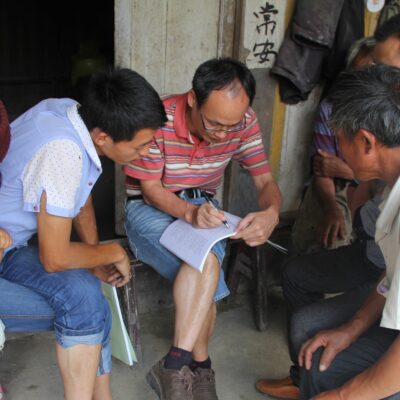China, a country rich in cultural diversity and historical depth, has numerous Indigenous communities. The official policy, however, designates these 55 groups as shaoshu minzu, which translates as ‘ethnic minorities’ or ‘minority nationalities,’ coexisting with Han minzu, or the Han nationality, thereby avoiding the phrase ‘Indigenous peoples.’ This is despite the fact that these communities have maintained long-standing ties to their ancestral lands across generations. Their collective wisdom, deeply rooted in Indigenous knowledge, have played a pivotal role in domains ranging from land conservation and language practices to cultural preservation and religious relationships with the natural environment.
The official narrative in China effectively enforces a form of Indigenous denialism through its policies, influencing and often limiting how ethnic identities can be expressed and recognised. Indigenous communities from ethnic minority groups encounter various disadvantages compared to the Han majority, such as lower life expectancy than the national and Han average, generally lower educational attainments, lower income earned by urban migrant workers, and a lack of representation in government.
The official policy framework has rendered the acknowledgment of Indigenous identities virtually inaccessible in official rhetoric. Incidentally, internal discussions have surfaced within some groups, such as the Tibetan diaspora, regarding the affirmation of their Indigenous status. Although the term ‘yuanzhumin’ (Indigenous people) lacks official endorsement in state discourse, its usage seems uncensored in the digital realm, particularly when referring to groups such as Tibetans.
Communities without official Indigenous status in China face significant barriers to exercising their Indigenous rights and preserving their unique cultures due to the absence of supportive legislation. Such governmental stances contribute to ethnic disparities and tensions, and some may argue the survival of culture and identity, particularly in contexts such as the preservation of Indigenous languages, the functioning of educational systems, and migration of Indigenous pastoralists for environmental preservation.
Sociologist Eduardo Bonilla-Silva, in his examination of racial relations in the United States, argues that while overt racism has declined, a subtler form of racism, termed ‘colour-blind racism’ or ‘colour-blindness,’ has taken root. This ideology, often adopted by the racial majority, denies racial prejudices through a ‘racial grammar’ that creates a normative field for racial interactions, thereby maintaining racial hierarchy in contemporary American society.
I aim to shed light on the denial of Indigenous identities in China, focusing on its implications for broader ethnic relations. To contextualise this analysis, I apply the concept of ‘colour-blindness’ to the socio-political context of China, drawing comparisons with Western societies, to understand the persistence of challenges faced by Indigenous communities in China.
Unity in diversity: ethnic governance in China
China’s management of its ethnic minorities is marked by a strategy that seeks to balance tolerance and integration. Historically, this approach has involved a nuanced alternation between leniency and stringency, reflecting the dual objectives of the nation’s policies: to acknowledge certain aspects of ethnic diversity while ultimately encouraging cultural assimilation. The country’s demographic makeup—a predominant Han Chinese majority that comprises about 92 percent of China’s vast population coexisting with various ethnic minorities—often sets the stage for this intricate dynamic in ethnic governance.
The Chinese government’s acknowledgement of ethnocultural pluralism is encapsulated through the representation of a pan-ethnic ‘Zhonghua Minzu’ (the Chinese nation), which encompasses all ethnic groups under this modern Han-centric national identity. While policies have been introduced to benefit ethnic minorities, including educational programs in native languages, scepticism persists regarding the true extent of support for ethnocultural diversity due to its Han-dominant perspective in national policymaking.
China’s ethnic governance strategy is said to be heavily influenced by the ‘duoyuan yiti’ or ‘pluralist-unity’ framework, proposed by Fei Xiaotong in the 1980s. This concept posits that all of China’s ethnic groups, despite their linguistic, cultural, and religious differences, are moving from ‘diverse origins’ (duoyuan or pluralism) to a ‘single body’ (yiti or unity) constituting the Chinese Nation. This ideology underpins China’s narrative on ethnic integration, which is deemed vital for national unity and stability.
In its ‘pluralist-unity’ model, China recognises ethnic diversity while promoting a unified national identity. This approach permits a degree of ethnic expression, particularly in areas such as minority language usage and cultural festivities. However, any overt demands for increased autonomy are denounced as unlawful challenges to established social harmony. Within this political landscape, for example, promoting education based on one’s native language from these minority groups, in accordance with the constitutional language rights of ethnic minorities in China, requires tactful expression to avoid inciting widespread protests. This delicate balance highlights the complexity of navigating ethnic identity within a framework that seeks unity while acknowledging diversity.
The ‘pluralist unity’ concept is not without contradictions in practice. For example, it promotes multiculturalism yet prioritises Mandarin as the national language that must be taught to minority children in preschools, often at the expense of non-dominant languages. An inherent contradiction lies in its ambiguity, signifying a plurality of ethnicities or nationalities while emphasising a singular and unified Zhonghua nation or race.
The ‘pluralist-unity’ ideal, therefore, presents a dilemma. It encompasses a wide range of ethnicities and cultures but tends towards the commonality in a unified Zhonghua nation. This paradox has profoundly influenced China’s ethnic policies, offering a foundation for those advocating ‘unified community of the Chinese nation’ and those who see diversity as a pathway to uniformity. This approach significantly impacts the education of Indigenous peoples in state-run schools in terms of choice of language of instruction in classrooms.
In multiethnic China, the Han community often emerges as the principal symbol of the nation’s modern identity. Historically, ethnic minorities have been portrayed as less advanced and in need of guidance towards modern norms of Han peers. This viewpoint, which is labelled ‘Han chauvinism’ underscores the Han-centrist tendency in defining national identity.
The question of Indigeneity in China
The reluctance of China to recognise Indigeneity among its ethnic minority communities is a multifaceted issue, deeply rooted in historical, political, and racial factors. Historian Mark Elliot points out that China’s stance is primarily driven by political motivations and interpretations of history. One of the key reasons for this avoidance is the potential legal and political challenges that could emerge from aligning with international standards on Indigenous rights, such as the United Nations (UN) Declaration on the Rights of Indigenous Peoples. Such alignment would not only open China to international scrutiny but also to potential claims in international forums such as the UN Permanent Forum on Indigenous Issues.
Second, the concept of Indigeneity, Elliot argues, presents a conflict with China’s broader effort to depoliticise ethnic identity, especially against the backdrop of ongoing tensions and the pursuit of national unity. Acknowledging the presence of Indigenous peoples within China could lead to heightened attention on ethnic and territorial claims, posing a fundamental challenge to maintaining national cohesion and stability.
Scholars such as Gray Tuttle have highlighted racial dynamics as a significant factor. He challenges the prevailing narrative that frames China’s policies towards ethnic minorities as mere authoritarian measures to crack down on dissents and centralise control over ethnically diverse border regions. For most Han Chinese people, minority groups such as Tibetans are not only ethnically distinct but, Tuttle suggests, may also be considered racially different.
James Leibold and Gerald Roche, applying Michel Foucault’s notion of ‘state racism’ offer a critical perspective on the systemic racism experienced by ethnic minorities in China. Their analysis illuminates how the process of ‘racialisation’ is systematically implemented through comprehensive surveillance measures targeting these groups. They suggest that the state’s approach to monitoring and controlling ethnic minorities not only reinforces their marginalisation but also institutionalises racism.
In Chinese society, entrenched ethnic prejudices manifest in the form of ‘racial sinicisation,’ which can have tangible effects on individuals’ lives, such as in labour markets where preferences for Han candidates are evident. These practices stand in stark contrast to the government’s proclaimed commitment to a multicultural Chinese society. On the surface, the state presents an image of inclusivity and cultural plurality. Yet, underlying attitudes and practices reveal persistent issues of racism and ethnic discrimination that are not only part of state policy but also public perceptions of ethnicity.
The unspoken racial dimensions within China’s ethnic policy reflect the state’s complex relationship with its Indigenous communities. These policies portray minority groups simultaneously as an integral part of the nation and as ‘the Other.’ In the following section, I offer a fresh look into the rationales underlying the justifications by leading Chinese intellectuals for this apparently contradictory policy strategy in ethnic governance, as well as the issues arising from it.
Depoliticising ethnicity: The hidden layers of colour-blind ideology
China’s ‘second-generation ethnic policy’ has sparked a scholarly debate, not censored by the government, about the role of ethnicity in modern China. This vision, not a formal legal policy document but spearheaded by scholars such as Ma Rong, advocates a paradigm shift in managing ethnic diversity. Central to this debate is the ‘depoliticisation’ of ethnic identities, a proposal urging a rethinking of minority policies to foster a sustainable solution to ethnic conflicts in minority areas, ultimately creating lasting peace and stability in ethnically diverse regions.
The ‘second-generation ethnic policy’ debate centres on ‘depoliticising’ ethnic identities. Its proponents argue that ethnicity should cease to be a defining factor in the social and economic trajectory of China’s ethnic minorities. It argues that classification of nationality (minzu) since the 1930s has inadvertently ‘politicised’ ethnicities by categorising these groups as political entities with territorial affiliations in their corresponding ‘autonomous’ states or provinces, thus having a negative impact on national cohesion.
Despite differing in their political and historical backgrounds, there are notable similarities between the ‘depoliticisation’ approach in China and the idea of ‘colour-blindness’ held by some in Western societies, particularly the United States. In the West, ‘colour-blindness’ has been critiqued for perpetuating the belief that racial and ethnic barriers no longer hinder the progress of historically marginalised groups. This ideology promotes the illusion of a ‘post-racial’ society, where the existence of inequality and its causes is often overlooked, and diversity is celebrated only to a certain extent. This perspective, despite its liberal roots, may inadvertently conceal the racial and ethnic underpinnings of inequality, hindering true progress toward equal treatment.
The depoliticisation notion emerging from China’s ‘second-generation ethnic policy’ debate strikingly echoes the discourse on colour-blindness by advocating for the reduction of ethnicity’s political significance. However, it risks oversimplifying the differences between ethnic groups concerning economic, educational, and social development. By advocating for depoliticisation of the group rights of ethnic minorities, the argument disregards structural inequalities associated with ethnicities that account for the underlying socio-economic disparities between the Han majority and ethnic minorities.
Echoing Eduardo Bonilla-Silva’s critique of colour-blind racism in America, China’s approach to depoliticising ethnic issues tends to downplay legitimate concerns about the role of race or ethnicity in persistent social and economic inequalities. This approach not only minimises the need for meaningful policy change but also fails to acknowledge the socio-economic privileges associated with the Han majority. Moreover, it overlooks the unique contributions of Indigenous knowledge and the deep connections to nature that minority groups hold, which are critical to the cultural and environmental richness of the nation.
In essence, the discourse surrounding China’s ‘second-generation ethnic policy’ and the push for ‘depoliticisation’ of its ethnic policies warrants a thorough examination. It mirrors the scepticism and critique surrounding colour-blindness observed by scholars studying Western societies. Therefore, a closer look at these issues requires understanding of how China acknowledges multiple ethnic identities while simultaneously ensuring national cohesion and social harmony.
Conclusion
The exploration of China’s ethnic dynamics reveals a critical issue: the state’s approach to its Indigenous populations is veiled in a form of ‘colour-blindness.’ This stance effectively prevents crucial introspection regarding systemic ethnic disparities and perpetuates racism and ethnic bias across various sectors, including education, employment, and broader societal interactions.
The impact of Indigeneity denialism transcends the traditional Han-minority relationship, affecting all communities under the overshadowing concept of ‘Han-ness.’ This prevailing paradigm inadvertently normalises racial and ethnic biases, positioning Han culture as the default and, in doing so, marginalises Indigenous identities.
China’s approach to governing its diverse Indigenous populations is encapsulated within its ‘plurality-unity’ framework. This strategy involves acknowledging ethnocultural diversity while simultaneously striving for assimilation. It represents the ongoing development of China’s ethnic governance, where the notions of unity, diversity, and colour-blind ideologies converge and influence one another.
Further reading: China’s official common language gains further strength against minority languages.
Image: A Bai woman, and two younger men, walking down a street in Yunnan, 2022. Credit: Rod Waddington/Flickr.




